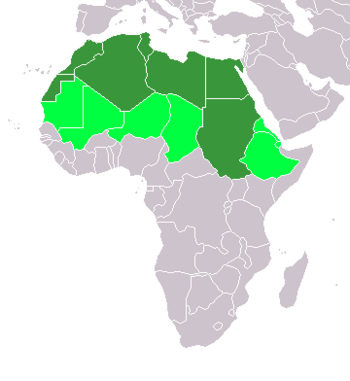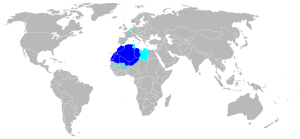Northern Africa
North Africa or Northern Africa is generally accepted to refer to the northernmost region of the African continent. The political definition of North Africa is highly disputed however, and there is no widely accepted definition of the region or list of countries that fall within the region. For the purposes of this article the United Nations definition of the region will be used. The UN defines North Africa as consisting of:
* The inclusion of Western Sahara in the UN list is highly controversial, as the territory is currently administered by Morocco but is also clamed by the Polisario Front.
Background
Some consider the borders of North Africa as stretching from the Atlantic shores of Morocco in the west to the Suez Canal in the east. While a convenient geographic definition, more often this broad expanse of territory is designated by the term Northern Africa. A more popular political definition of North Africa limits the term to those countries who were formerly known as known Africa under French colonism. Definining North Africa in this way limits the term to Morocco, Algeria, and Tunisia.
A prominent geographic feature of the region is the Atlas Mountain range, which extends across of Morocco, northern Algeria and parts of Tunisia. The Atlas Mountain Range also served to faciliate agriculture in the region, as most farming takes place in small valleys sheltered from the harsh winds by the mountains. Farming in this manner is also seen in the alcoves created in the Nile Valley and delta and along the Mediterranean coast. Under the sheltered conditions of valley farming a wide variety crops can be grown including: cereals, rice and cotton, and woods such as cedar and cork. Along the coast of the Mediterranean crops such as olives, figs, dates and citrus fruits are also cultivated. Some North African nomads, such as Bedouin, choose another system of agricultural cultivation and maintain their traditional pastoral lifestyle on the desert fringe. In moving their herds of sheep, goats and camels the Bedouin often cross political borders to find suitable grazing lands.
After defining the landscape in the region, the Atlas Mountian range descends southward and transforms into a steppe landscape before meeting the Sahara. The Atlas mountain range in North Africa is a portion of the fold mountain system that runs throughout parts of Southern Europe.
Culture and Religion
The earliest inhabitants of North Africa were the Berbers, an indigineous group that formed the first civilizations in North Africa in the 5th and 4th century B.C.E. Contact with the Berbers was documented by the Egyptians, Abyssinians (Ethiopians) and Nubians who lived in the northeastern portion of the African continent. While the homelands of these groups are not included under the UN definition of North Africa, must scholars include them when discussing the history of human occupation in the region.
Ethnically, scholars divide North Africa into three regions: The Maghreb, the Nile Valley and the Sahara. The popualtions of the Maghreb and the Sahara are closely linked through linguistics, as both groups speak dialects that derive from either the berber language of Arabic. While it may seem on first glance that Berber and Arabic are very different languages, they actually exhibit many similarities, as both are members of the Afro-Asiatic language family. Besides a linguistic link between the Maghreb and the Sahara, the populations are also connected along ethnic lines. Ethnic lines are often blurred in the Maghreb, where both the Arabic and the Berber cultures exercise a strong influence on the culture. It is common for a Berber and Arabic speaking individuals in North Africa to identify with the opposite culture of their language due to social and political circumstances. The Berber cultural identity underwent a revival in the 20th century and campaigned to maintain a distict culural identity.
While North Africa is predominantly Muslim, a small Jewish population also existed in the region prior to decolonization. When many countries in North Africa gained independence, much of the existing Jewish community emigrated to France. The formation of Israel also contributed to the mass emigration of the North African Jewish population. Today, the Jewish population in North Africa numbers less than fifteen thousand, almost all of which are centered in Morocco and Tunisia.
History
Antiquity and Ancient Rome
The most notable nations of antiquity in western North Africa are Carthage and Numidia. The Carthaginians were of Phoenician origin, with the Roman myth of their origin being that queen Dido, a Phoenician princess was granted land by a local ruler based on how much land she could cover with a piece of cowhide. She ingeniously devised a method to extend the cowhide to a high proportion, thus gaining a large territory. She was also rejected by the Trojan prince Aeneas according to Virgil, thus creating a historical enmity between Carthage and Rome, as Aeneas would eventually lay the foundations for Rome. The Carthaginians were a commercial power and had a strong navy, but relied on mercenaries for land soldiers. The Carthaginians developed an empire in Spain and Sicily, the latter being the cause of First_Punic_War with the Romans. Over a hundred years and more, all Carthaginian territory was eventually conquered by the Romans, resulting in the Carthaginian North African territories becoming the Roman province of Africa in 146 B.C.E. This led to tension and eventually conflict between Numidia and Rome. The Numidian wars are notable for launching the careers of both Marius, and Sulla, and stretching the constitutional burden of the Roman republic, as Marius required a professional army, something previously contrary to Roman values to overcome the talented military leader Jugurtha. North Africa remained a part of the Roman Empire, which produced many notable citizens such as Augustus of Hippo, until incompetent leadership from Roman commanders in the early fifth century allowed the Germanic barbarian tribe, the Vandals, to cross the straights of Gibraltor, where upon they overcame the fickle Roman defense. The loss of North Africa is considered a pinnacle point in the fall of the Western Roman Empire as Africa had previously been an important grain province that maintained Roman prosperity despite the barbarian incursions, and the wealth required to create new armies. The issue of regaining North Africa became paramount to the Western Empire, but was frustrated by Vandal victories and that the focus of Roman energy had to be on the emerging threat of the Huns. In 468, the last attempt by the Romans, with Byzantine aid, made a serious attempt to invade North Africa but were repelled. This is placed as the point of no return for the western Roman empire in a historical sense and the last Roman Emperor was deposed in 475 by the Ostrogoth generalissimo Odoacer who saw no purpose in regaining North Africa. Trade routes between Europe and North Africa remained intact until the coming of the Moslems.
Muslim invasion and subjugation to modern times
The Arabic Muslims arrived in North Africa in 640 C.E. By 670, most of North Africa had fallen to Muslim rule. The Berbers subsequently started to form their own kingdoms in response to this threat in places such as Fez, Morocco, and Sijilimasa. In the eleventh century a reformist movement made up of members that called themselves Almoravids, launched a jihad against the kingdoms to the south in the Savanna. This movement solidified the faith of Islam, and allowed for penetration into sub-sahara Africa. After the Middle Ages the area was loosely under the control of the Ottoman Empire, except Morocco. After the 19th century, it was colonized by France, the United Kingdom, Spain and Italy. In World War II from 1940 to 1943 the area was the setting for the North African Campaign. During the 1950s and 1960s all of the North African states gained independence. There remains a dispute over Western Sahara between Morocco and the Algerian-backed Polisario Front.
Modern Day North Africa
The economies of Algeria and Libya were transformed by the discovery of oil and natural gas reserves in the deserts. Morocco's major exports are phosphates and agricultural produce, and as in Egypt and Tunisia, the tourist industry is essential to the economy. Egypt has the most varied industrial base, importing technology to develop electronics and engineering industries, and maintaining the reputation of its high-quality cotton textiles.
Oil rigs are scattered throughout the deserts of Libya and Algeria. Libyan oil is especially prized because of its low sulphur content, which it means it produces much less pollution than other fuel oils.
ReferencesISBN links support NWE through referral fees
- Lewis, Brenda Ralph. Great Civilizations. Bath: Parragon Publishing, 1999. ISBN 0752561413
- Costantino, Maria. The Illustrated Flag Handbook. New York: Gramercy Books, 2001. ISBN 0517218100
- Davidson, Basil. West Africa Before the Colonial Era: A history to 1850. Essex: Pearson Education Limited, 1998. ISBN 0582318521
- Encyclopedia Britannica Retrieved July 10, 2007.
External links
- The North Africa Journal Analytical magazine
- Energy and Mining
- Industries and Markets
- Politics and Diplomacy
- Finance and Banking
- Agriculture and Tourism
- Corporate Affairs
- Social and Labor Affairs
- north-of-africa.com news and culture
See also
- European Digital Archive on Soil Maps of the World
- Northern Africa Railroad Development
| Regions of the world | |||||||||||||||||||||||||
|---|---|---|---|---|---|---|---|---|---|---|---|---|---|---|---|---|---|---|---|---|---|---|---|---|---|
|
| ||||||||||||||||||||||||
| See also Continents of the world | |||||||||||||||||||||||||
Credits
New World Encyclopedia writers and editors rewrote and completed the Wikipedia article in accordance with New World Encyclopedia standards. This article abides by terms of the Creative Commons CC-by-sa 3.0 License (CC-by-sa), which may be used and disseminated with proper attribution. Credit is due under the terms of this license that can reference both the New World Encyclopedia contributors and the selfless volunteer contributors of the Wikimedia Foundation. To cite this article click here for a list of acceptable citing formats.The history of earlier contributions by wikipedians is accessible to researchers here:
The history of this article since it was imported to New World Encyclopedia:
Note: Some restrictions may apply to use of individual images which are separately licensed.

